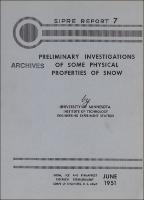Please use this identifier to cite or link to this item:
https://hdl.handle.net/11681/24281Full metadata record
| DC Field | Value | Language |
|---|---|---|
| dc.contributor.author | Bader, Henri, 1907- | - |
| dc.contributor.author | Joseph, Jerome A. | - |
| dc.contributor.author | Sandgren, Marvin A. | - |
| dc.contributor.author | Hansen, B. Lyle | en_US |
| dc.date.accessioned | 2017-09-25T18:30:14Z | - |
| dc.date.available | 2017-09-25T18:30:14Z | - |
| dc.date.issued | 1951-06 | - |
| dc.identifier.uri | http://hdl.handle.net/11681/24281 | - |
| dc.description.abstract | Work on the Snow Classification project has been confined to measurement of the properties of the various types of snow found in a natural snow cover and no attempt has been made to develop instruments or procedures for measuring the mechanical properties of compacted snow layers. During a portion of the past winter the snow cover on the campus was systematically classified in accordance with the International Association of Hydrology's Tentative Snow Classification. At the same time samples were taken into the laboratory and tested. The tensile strength and shear strength were measured with the centripetal force and single shear apparatus. An attempt was made to correlate readings from the drop cone penetrometers with data obtained by the National Research Council plate type Hardness Gage. It seems that the shear strength vs. normal stress curves are characteristic of snow type and may therefore be useful for the classification of snow. The problem of resistance to penetration as a measure of hardness must be investigated further, but it was tentatively concluded that curves like Figures 22 and 23 obtained by means of the N.R.C. hardness gage are more reliable than data from a drop cone penetrometer. Work on the basic mechanics of snow compaction project has not progressed far beyond an initial stage of instrumentation. Actual work on snow has been of an entirely preliminary and exploratory nature; the object being to gain an over-all concept of snow· as 'a material, to evaluate the qualities of its properties, to create a measure of understanding of the problems to be solved, of the minimum scope of necessary research. The realization of the danger of proceeding with systematic quantitative measurements before the pertinent variables are reasonably well known has been ever present and has led to a continuing reappraisal of objectives, to much theoretical work and to much modification of instruments. Besides the rapid evolution of concepts, which inevitably create some hesitance in procedure, the main difficulties have been: lack of availability of sufficiently similar snow samples in large number, late delivery of purchased items, considerations of expenditure, an initial underestimation of the necessary degree of precision in measurement, and an uncertainity as to the number, nature and range of the variables to be considered. When specimens are subjected to destructive tests, a number of closely similar specimens must be available. Snow shovelled into cardboard boxes for storage was found to be insufficiently homogeneous for our purposes. Attempts at homogenization by screening into boxes were also a disappointment. The best way to obtain similar samples is either to cut them out of the snow layers in the field with a standard sample tube or to screen snow directly into tubes. A sufficient number of tubes could not be obtained until too late to be of much use. This is mentioned as a material obstacle to work on both projects. If work on a given snow type is to proceed for some time very cold storage (below -30°) is indispensable because the snow .changes due to inherent instability at higher temperatures. Such storage was unavailable conveniently close to the laboratory during most of the contract period. In spite of the mentioned difficulties real progress has been made as set forth in this report. The restriction to few examples in listing of numerical results of measurements facilitates the understanding of a rather complex subject. The incorporation of more experimental data would yield no additional clarification. Furthermore, most of our measurements are worthless as an accumulation of data for future reference because of inadequate correlation with other properties. The time for systematic work of correlation of a larger number of dependent variables has been brought nearer by the work outlined in this report but was definitely not here at the time the work was done. A perusal of this report shows that the specific investigations called for by the contracts could not be profitably undertaken without knowledge of the underlying principles of snow mechanics. This groundwork has yet to be laid and herein rests the main value of our investigations. Some of the paths of future research are now well understood, and the necessary instrumentation has reached a relatively useful stage of development. | en_US |
| dc.description.sponsorship | University of Minnesota. Engineering Experiment Station. | en_US |
| dc.language.iso | en | en_US |
| dc.publisher | U.S. Army Snow, Ice, and Permafrost Research Establishment. | en_US |
| dc.relation.ispartofseries | SIPRE Report;7 | - |
| dc.subject | Snow mechanics | en_US |
| dc.subject | Snow | en_US |
| dc.title | Preliminary investigations of some physical properties of snow | en_US |
| dc.type | Report | en_US |
| Appears in Collections: | Technical Report | |
Files in This Item:
| File | Description | Size | Format | |
|---|---|---|---|---|
| SIPRE Report 7.pdf | 55.89 MB | Adobe PDF |  View/Open |